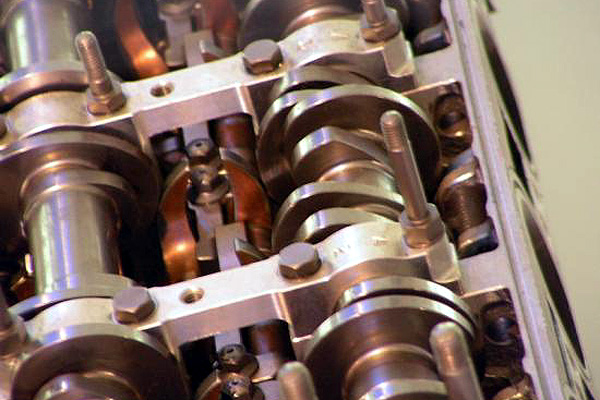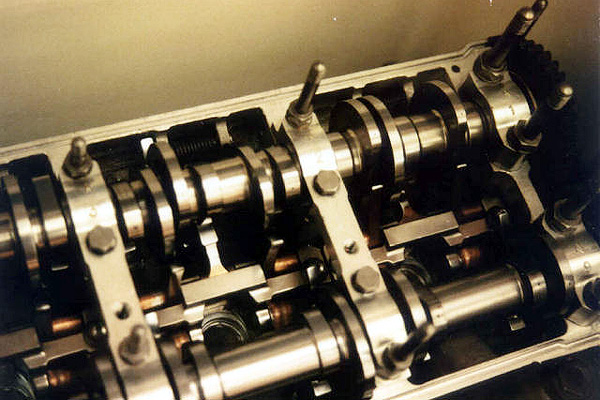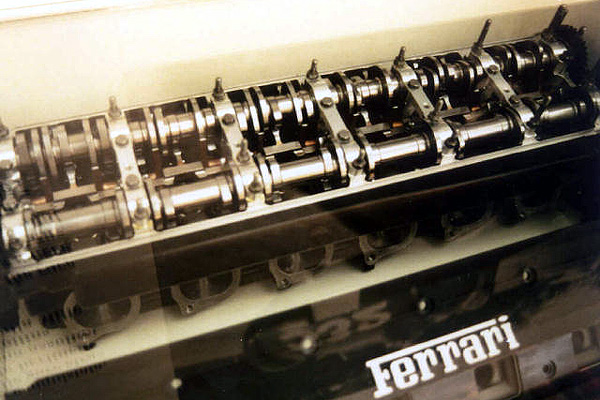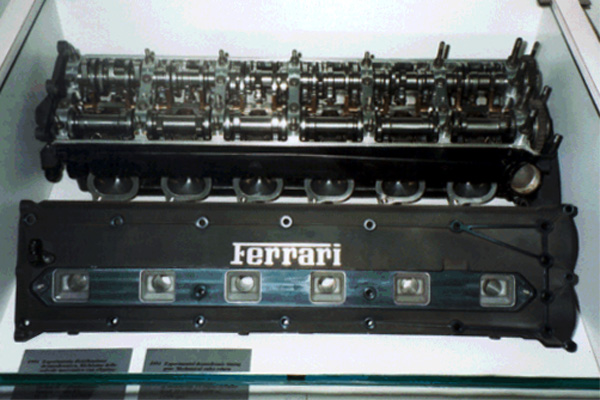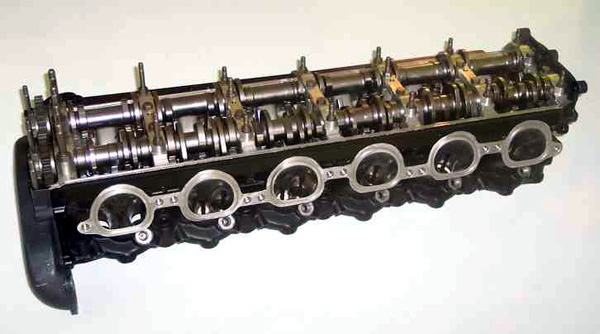| Desmodromic History |
デスモはドゥカティの専売特許のように思われがちだが、実際は古い技術で、バルブスプリングのサージング問題に頭を悩ませてきた先人たちが、その解決策として具現化してきたものである。
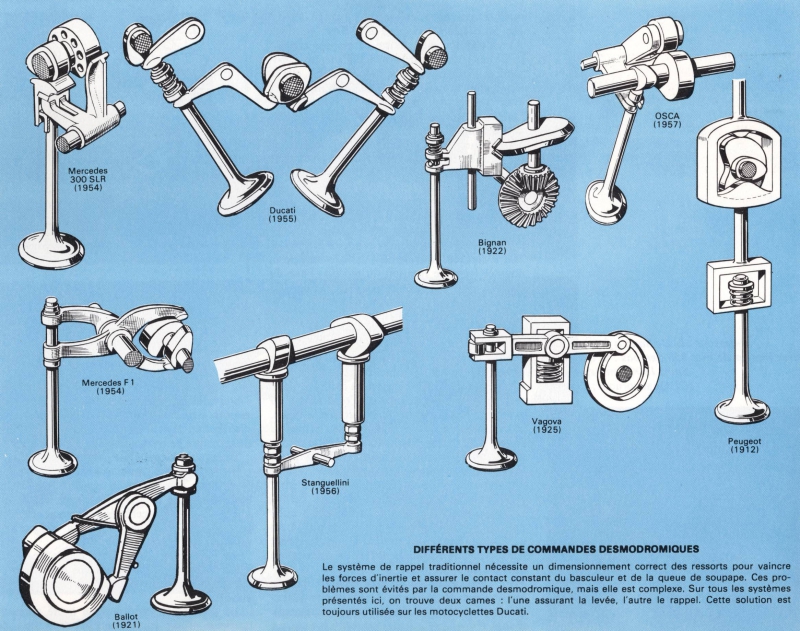
The word “desmodromic” derives from two Greek words: "desmos" (controlled, linked) and "dromos" (stroke, course, track). In mechanics, it is used to refer to mechanisms which have a control for movement in one direction and another special control for movement in the opposite direction (“closure” or “return”). Today, "desmodromic" commonly refers to the typical valve control system of Ducati motorcycles.
1889: Daimler Benz - The first patented desmo - Germany
The first known system desmodromic patented in 1889: it was created in Germany by Daimler-Benz for a car equipped with a V-twin Panhard et Levassor and Peugeot have even made this engine licensed for production models in 1890 and 1891! Notice the sump-pump inlet type 2 time (2 stroke), automatic intake valves into the pistons and exhaust valves side desmodromic valves.
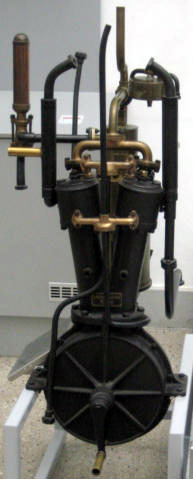
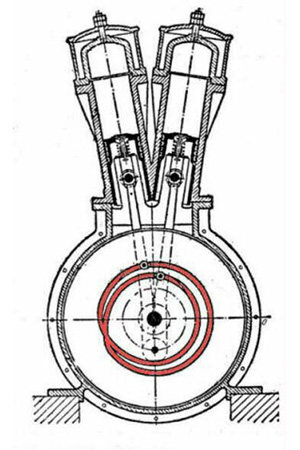
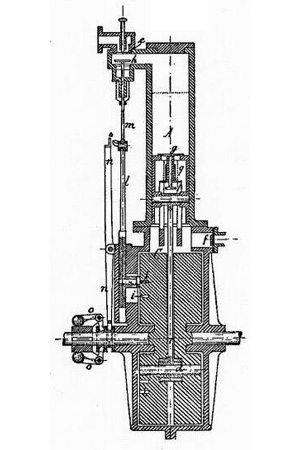
1910: Arnott (or JAP) - UK
The French ClaudeBonjour then filed a patent hydrostatic system in Switzerland in 1893 followed by the German Gustav Mees in 1896 and Arnott English in 1910.
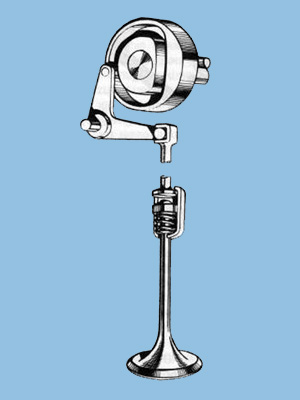
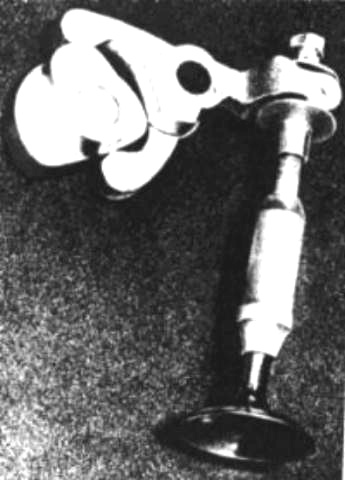
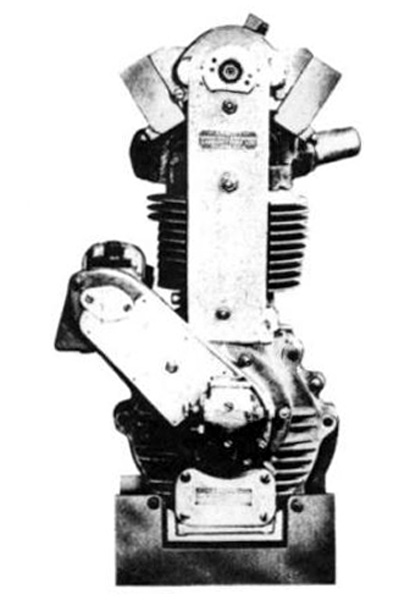
1912: Peugeot - France

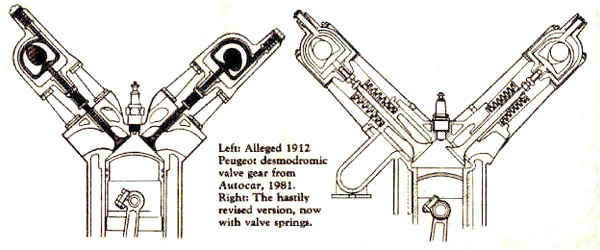
高名なGPレーサーである Peugeot L76 は当初、デスモであったが、後にバルブスプリングを持たされるようになった。
In numerous sources the Peugeot 1912/1914 system is (still) regarded desmodromic. The stirrup type camfollower system might have initiated a forced up- and down movement of the valve. But since there was not a fixed camfollower - valve connection, I always regarded the system as semi (part of the valve train) desmodromic. In Griffith Borgeson's article "The signature of the artist : Debugging the Desmodromic Dichotomy and other historical fantasies", published 1986 in "Automobile Quarterly"; Vol. 24 no. 3,
1914: Delage - France
Delage cars have a desmodromic valve control obtained with a "shaped annular cam".The French manufacturers Bignan build a sports car powered by a desmodromic engine: the valve control is a very special system, based on a "skew disc circular cam". This car won the Spa 24 hours race and set some speed records on the Brooklands circuit in England, but the mass production stage was never reached because of heavy maintenance and the high production costs involved.
By the result in 1912 and 1914 Peugeot and Delage created their own systems for single-seater Running.
The prehistory of "desmoquattro": the 4-cylinder 4.4 liter (about 120 hp at 2400 rpm) of the Delage Grand Prix 4 valves desmodromic 1914 is the work of the engineer Arthur Michelat. A single copy of this car still exists, she took the 5-th place in the Indianapolis 500 in 1916.
Note the original system composed of a single device controlled by three cams (one opening and two closing) and driving two valves.
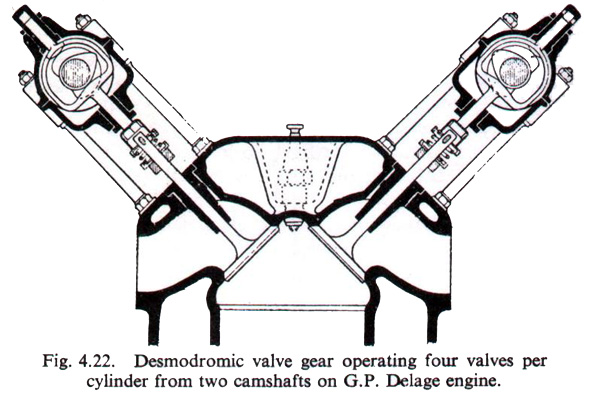
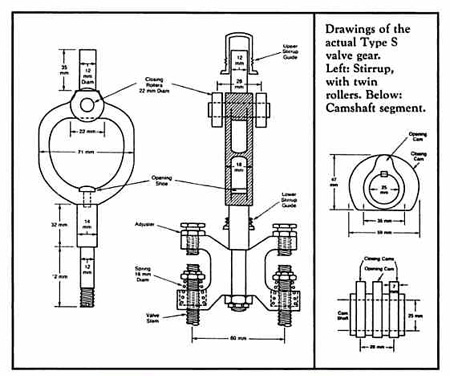
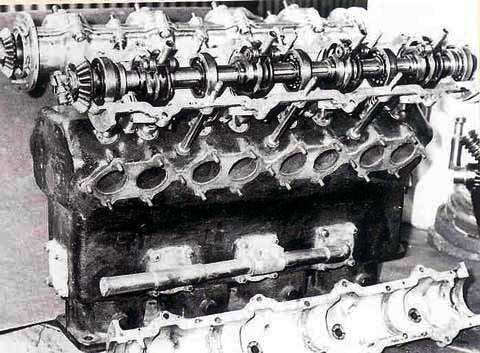
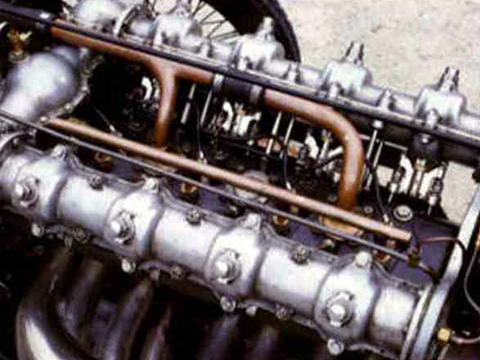
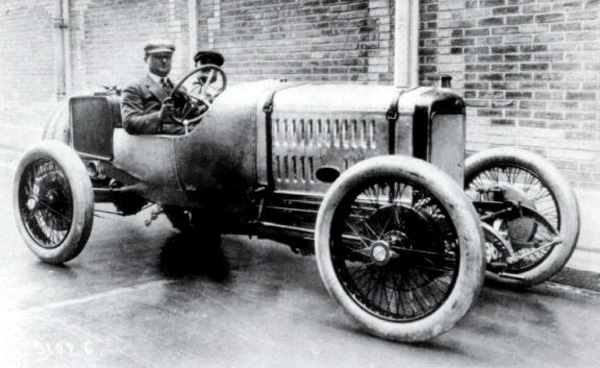
1921: Ballot -

Ballot をデスモとする意見はあるが、実際はデスモではないようだ。
Further comment by Sebastien Faures, a Vintage car specialist from France:
Ballot was an engine manufacturer only before WWI, his first cars appearing after WWI. In 1919, Ballot launched its famous twin-cam 8 cyl. 5 liters racing car on the Indy track.
For 1920 and 1921, this racing car was scaled down to 3 liters to be in accordance with new Indy and Grand Prix regulations.
All these cars were designed by the Swiss engineer Ernest Henry.
Ernest Henry was previously the designer of the famous racing Peugeot twin-cam 1912-1914. As it has been demonstrated by Griffith Borgeson, none of the Peugeot's was Desmo. As it is clearly shown on Ballot drawings, neither the 1919 nor the 1920 Ballot cars were Desmo, and there is a very high probability that the 1921 car was identical to the 1920 car. For 1921, Ernest Henry designed the Ballot 2 liter twin-cam (4 cyl only) as well, which was the first commercial touring car ever with a twin-cam engine. This was the Ballot 2LS. This engine was neither a Desmo. Before the end of 1921, Ernest Henry left Ballot for Sunbeam where he designed the 1922 Sunbeam Grand Prix car. This car also was not Desmo. After 1922, Ernest Henry never designed any engine again.
At Ballot, at the end of 1921, after the departure of Ernest Henry, a new chief engineer called Louis Germain (from Panhard-Levassor) was entrusted to design a more simple car and so cheaper touring car for mass production than the 2LS. This became a 2 liter 4 cyl. with a single overhead camshaft and vertical valves. The car was called the Ballot 2LT and was presented at the end of 1922. Later Ballot wished to replace the sporty 2LS as it was too expensive to produce. Several studies were made by Louis Germain to create then a sporty derivative of the 2LT. The result was the Ballot 2LTS: same cylinder-bloc as the 2LT (so 4 cyl and 2 liter), with as well a single overhead camshaft, but with sporty hemispherical combustion chambers allowed by V-shape valves (internal angle: 45ー) driven by the overhead camshaft via rockers.
The Ballot 2LTS was presented in 1925. So it is highly probable that it was when working on the 2LS replacement, leading to the 2LTS, that Louis Germain studied the eventuality of a Desmo system, the one described in the patent. In addition: - the Desmo system described in the patent is shown on a single overhead camshaft engine with V-shape valves (but here the angle is 77ー), so you see the relation with the 2LTS studies (and Ernest Henry never designed a single overhead camshaft engine), - the date of the patent is end 1924/end 1925, exactly the period when Louis Germain was chief-engineer at Ballot (at that time Ernest Henry had left Ballot already for at leat 3 years) and exactly the period when the 2LTS was being studied.
conclusions:
- Ernest Henry, as great as he was, never designed a Desmo engine.
- So none of the Peugeot and Ballot racing cars did have a Desmo engine.
- The only Desmo impact in all this is solely a study (no physical application, other than in possible prototype form)
made by Louis Germain, when studying the Ballot 2LS replacement.
1922: Bignan - France
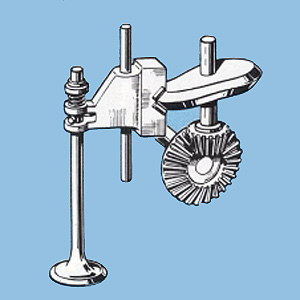
The French manufacturers Bignan build a sports car powered by a desmodromic engine: the valve control is a very special system, based on a "skew disc circular cam". This car won the Spa 24 hours race and set some speed records on the Brooklands circuit in England, but the mass production stage was never reached because of heavy maintenance and the high production costs involved.
1923: Fiat 401 in tipo 801 - Italy
The three liter Tipo 401 motor of 1920, was Fiat's first twin-cam engine. Starting in 1920 the type numbers of Fiat top-category racing cars began with 801 and their correspnding engine with 401. "This complicated engine ran only briefly and in prototype form in the T.801 racing car".
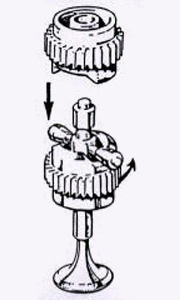
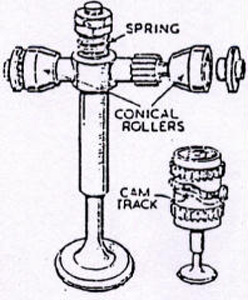
Here is the FIAT solution, based on a "double face cam and roller stud".
1924: JAP - UK
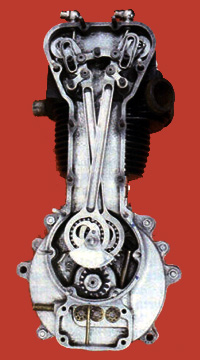
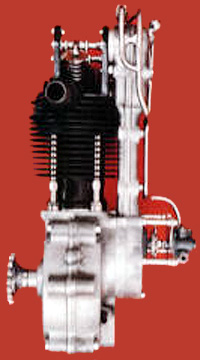
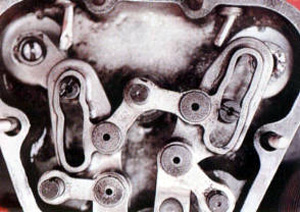
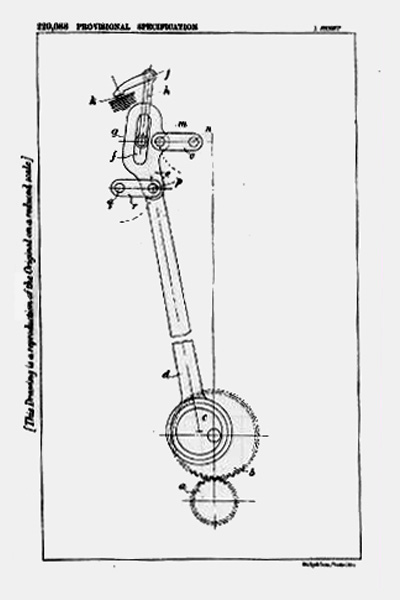
1925: Vagova -
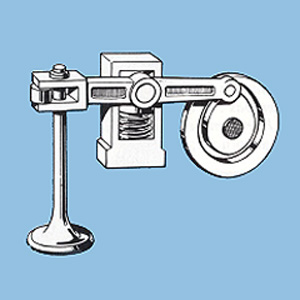
1954: Mercedes Benz W196 - Germany
Two years before the first Ducati desmo of 1956, this system has really proved its effectiveness for the first perfect When Daimler-Benz.Mercedes began the study in 1952 and then filed a patent in 1954. The design is particularly simple, logical and compact Manfred Lorscheidt combined a button and a rocker arm mounted on eccentric.
This system was later school and Taglioni was inspired by modifying it with two rocker arms per valve to bypass the patent (which never applies to a principle but only in drawings and their description).
Note the valve angle of 90 °, the pushers cylindrical opening, the admission very straight in the center and the cylinder head finally welded to the cylinder block. The threaded hole in the top left of the cylinder comes to receive the direct injection sprayer.
We can distinctly see the welds on the picture of the engine placed below. One may wonder how they replaced a valve eventually burned ...
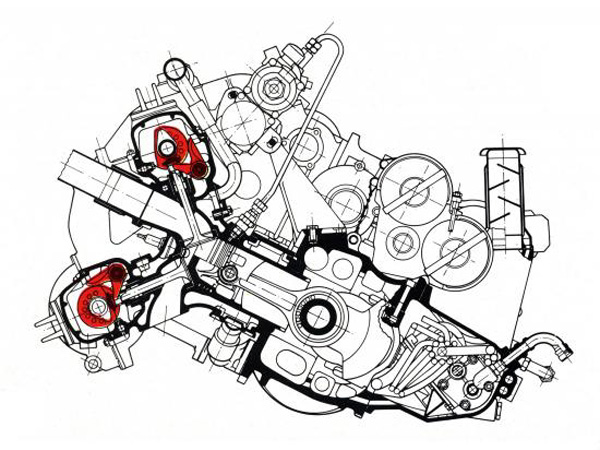
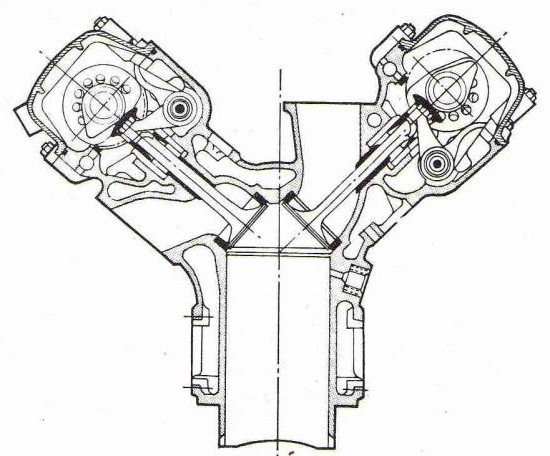
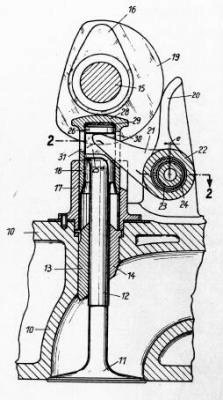
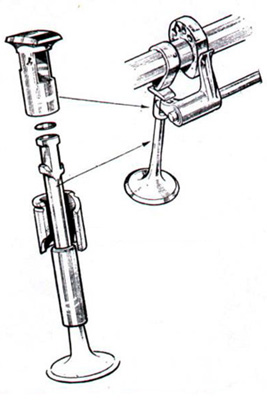
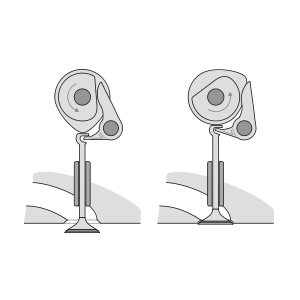
The Mercedes W196 (2.5 liter 8 cyl / 290 hp at 8700 rev / min) were beaten by world champion Formula 1 with Juan Manuel Fangio and Stirling Moss (vice champion) in 54 and 55.
This same engine in version 3 liters (310 hp) allowed Stirling Moss won the Mille Miglia with 300 SLR sports-seater and the world championship "sports" in 1955. Two unique cut 300 SLR desmo for the road with doors butterfly cut nicknamed "Gullwing" were built, one of them is exposed to the Mercedes Museum in Stuttgart. (See photos at end of section "Bibliography").
That writes LJK Setright, member of "The Institution of Mechanical Engineers" in his book "Some unusal engines": "The principle of the system distriburion Mercedes-Benz was pretty simple, although it is likely that the materials and technical and human resources used were first rate.
But perhaps the most interesting and unique was the removal of the small final closing spring which had always seemed necessary.
Mercedes discovered that 'leaving a tiny residual clearance of 0.03 mm and in the mechanism by simply leave the "desmo" return valve in the closed position, the inertia of the valve and the gas pressure in the cylinder sufficient to maintain the closed ..... .... during the two years of competition, the engine power went from 265 to 295 hp thanks to enormous lengths valve opening with perfect reliability and 340 hp at 9000 rpm would initially referred surely been exceeded if the project had been completed with induction pipes of varying length.
" At that time the panic of the valves was not really a problem, but mounting springs very hard had big drawbacks .
Only a system desmodromic permitted such levees and opening times of valves with perfect smoothness.
It is therefore Mercedes deserves credit for having understood, but it was not possible to achieve a "desmo" reliable without the tremendous progress achieved in metallurgy in the aircraft industry during World War II.
The Mercedes engine desmo 196 M: 8 cyl in-line, double overhead cam head, Bosch direct injection, dual ignition and dry sump. PTO (power take-off) is at the center of the crankshaft and the set consists of two blocks of four cylinders placed side by side and partially constructed in mechanized welding.
Note the presence, unique at the time on a racing engine , an air box with dynamic power before the intake funnel. Mercedes was a pioneer!
Mercedes obtained exceptionally good results and applied the desmo concept to Formula 1. The fabulous 8-cylinder W196, used by Fangio to win two world championships, was based on a highly developed, and at the same time, essential control system: an opening cam directly controls a shoe at the upper end of the rod (cylindrical tappet), while another closing cam uses an out-of-alignment rocker arm, which engages in a hole provided in the same tappet. AN ANECDOTE Enzo Ferrari, worried by the performance of the "Silver Arrows", was giving a lot of thought to desmo at the time. He even talked to Taglioni about it: perhaps, the Ducati desmo was born right then!
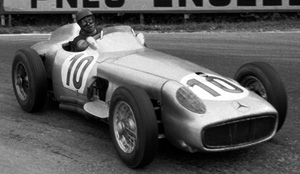
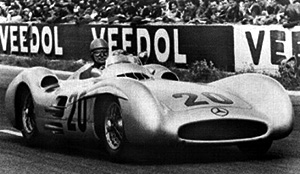
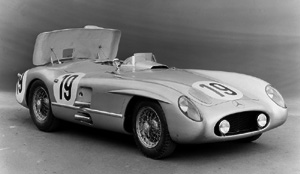
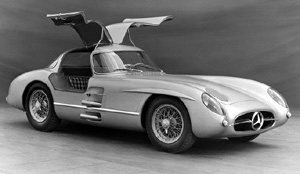
ベンツの戦後を飾る、1954 〜 1955 年のレーシングカーは一括して W196 と呼ばれる。その中で、GPレーサーを「W196R」(レンワーゲン)、スポーツカーレースに参戦した物を「W196S」(シュポルト)と呼び分けている。300SLR とは W196S の 別称である
1955: Ducati by Fabio Taglioni - Italy
"Ingegner" Taglioni leads the way to the Ducati desmodromic system: for the first time, a desmodromic timing system with three overhead camshafts, driven by a vertical shaft and a bevel gear, is mounted on a 125 Grand Prix bike: this bike and its rider Degli Antoni win the first race, the Swedish GP. From now on, the desmodromic system becomes a Ducati exclusive.As for Fabio Taglioni, it is in October 1956 he patented his first desmo Ducati 125 for a single-cylinder Grand Prix with three camshafts: the "trialbero"
Following the success of Mercedes and Ducati there was a renewed interest in the desmo and some have tried to imitate them: Volkswagen and Porsche, Fiat, Ferrari, Osca, and also Maserati prototype with a V12-2.5 desmo-liter Formula 1 in 1959, BRM, Cosworth, Scarab United States in 1960 on a Formula 1 (2.5-liter 4-cylinder), and other car. Neander, Moto Morini, MV Agusta, Honda (11 patents), Norton, Velocette-BMG, Suzuki, BMW, Mototrans and Merlin (licensed Ducati) by motorcycle to name a few. But very few have gone beyond the prototype stage and larger world there is no risk after 70 years apart BMW (unsuccessfully) in 91 although many patents have been filed.
Finally apart Ducati desmo all prototypes in motorcycle remained in draft form only and car Mercedes, Osca and Scarab adventure led to the end.
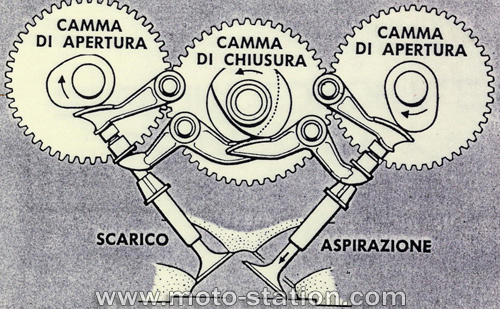
GP125 - trialbero
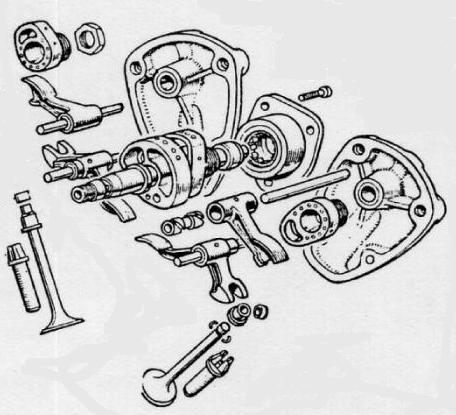
1956: Stanguellini - Italy
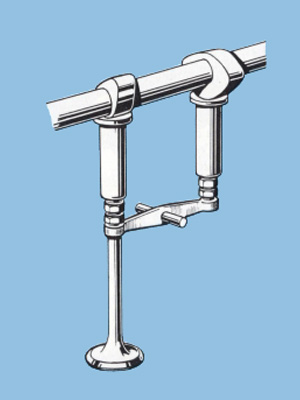
1957: OSCA - 4 cylinder 1500 / 2000 (Maserati 372 DS)
In 1957 Osca started to develop engines 4 cylinder Desmodromic which were mounted on spiders, the 1500 and 2000 "Desmodromico" (137 and 172 hp) and MT4 2 sport of Formula (1500 cc).In fact, spiders "desmodromico" produced in very few copies still remain the only cars desmodromic the world to have been marketed. Stritling Moss has a superb and unique spider FS racing bodywork in aluminum by Morelli and equipped with 1500 DS engine 372 desmo.
Osca The desmo were engaged in competition only a few occasions but that of Stirling Moss still has two podium finishes to his credit.
Ludovico Scarfiotti part in the Targa Fiorio in 1962 at the wheel a 4-cylinder desmo Osca two liters (photo) and led the race before the victorious Ferrari before something, not distribution, not loose.
The engine developed 498 DS 175 hp at 6,500 rpm, Carlo Maserati, its designer, said that the torque at medium speed was fantastic. Scarfiotti in 1961 also won the hill climb of Pontedocime-Giovi and race on Vallelunga Osca 2 liters desmo.
In 1963 Osca signed a technical cooperation contract with MV Agusta MV and a prototype desmo-Osca have been built. Finally the Maserati brothers stopped their activity in 1967, leaving behind a pretty successful sport.
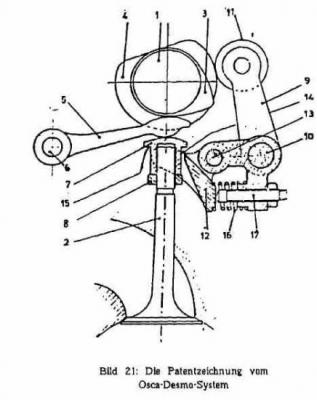
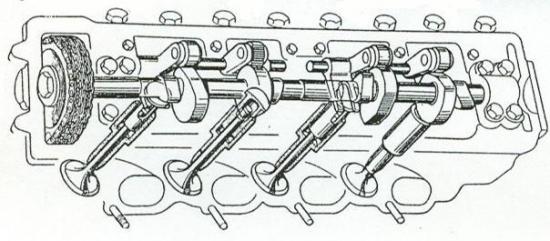
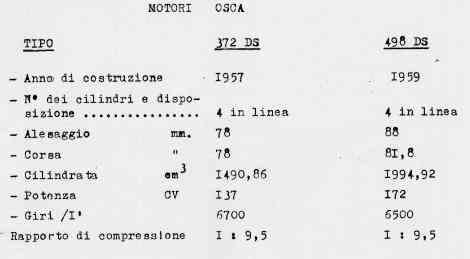
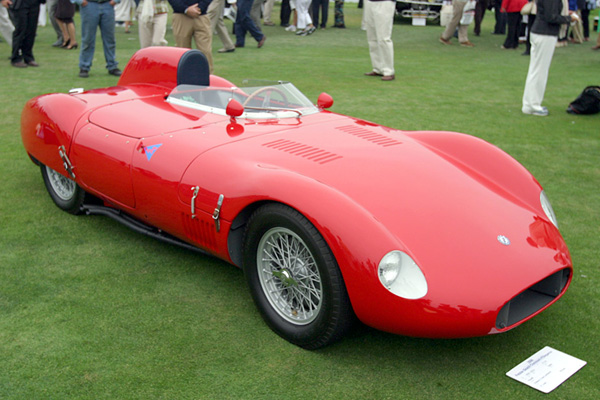
OSCA 372 FS Morelli Spider
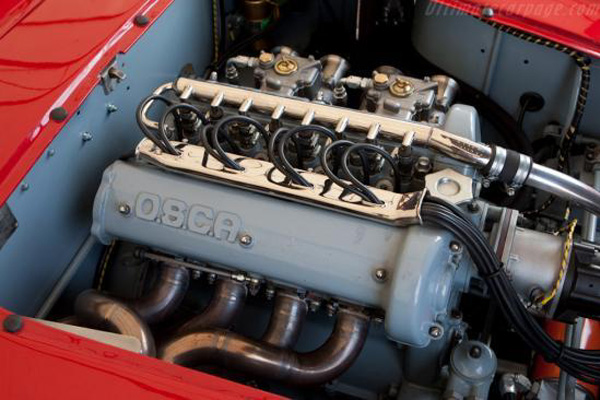
1957: NORTON MANX 350 & 500 - Prototype desmo 4 camshafts - UK
The Mercedes system had evolved from an idea of J.L. Norton, founder of the Norton factory, who at last, had designed a 500cc motorcycle with four overhead camshaft desmodromic timing: however, the resulting system was too bulky and complicated and Norton's idea was abandoned.In early tests the power was not greater than the twin cam, but it is mostly because of time and resources than Hopwood and Douglas Herbert Hele, Norton engineers who created it, have not pursue its development, two versions were made, a 350 and a 500 cc.
The 350 has also been tested in secret trials of the TT in 1959. We can also note the similarity with the Mercedes system (a pusher and a rocker).
Moreover another prototype desmo was directed by Bryan Thomas. This time it was a double (or triple?) Camshaft for the 350 Manx Norton.
The works of B.Thomas: left his 350 cc engines which are painted black housings are replicas of 500 desmo four camshafts factory!
Other Manx "desmo" were designed like those of Joe Potts and Harry Hinton as their private work.
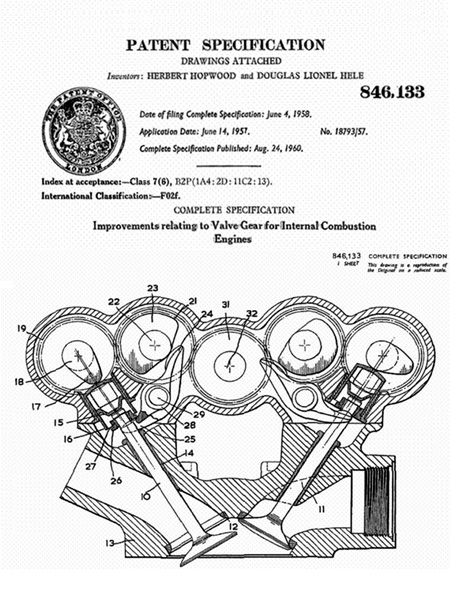
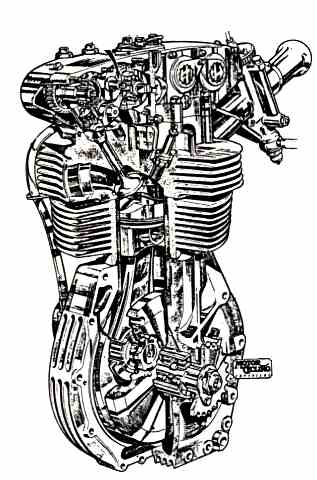
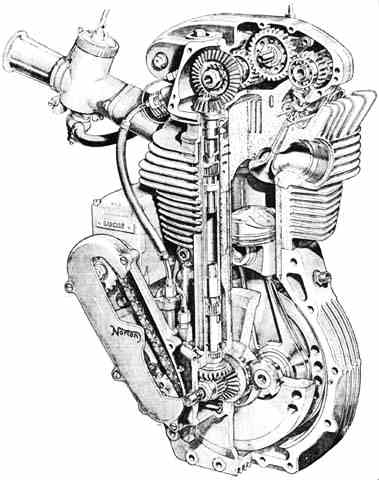
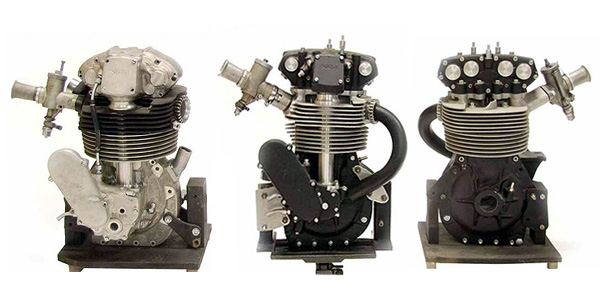
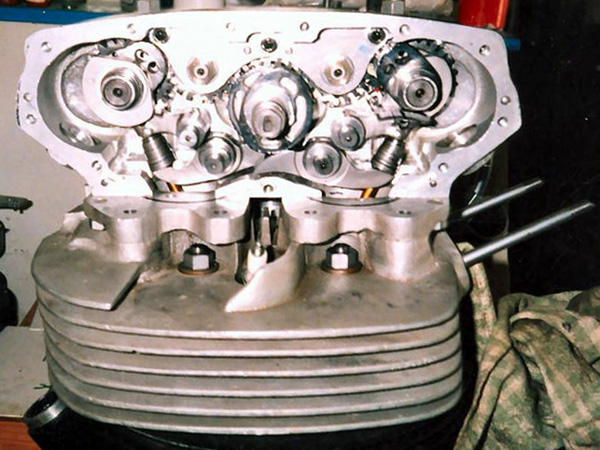
Doug Hele (1919 - 2001) designed and made two desmodromic heads in 1957.
Work continued in 1958, and in 1959 a 500 engine was taken to the TT. Bob McIntyre tried the desmo in TT practice but reverted to a conventional engine for the races.
"The desmo programme showed promise but we didn't have the time or resources to recognise its potential. There were too many other things going on at the time..... The desmo project died a quiet death."
Hele: "We spent a lot of time making different cams, but we never got more power from the desmo than a standard engine would produce. More time was needed on the engine, but that is one resource that development engineers are always short of."
1958: Ariel - UK
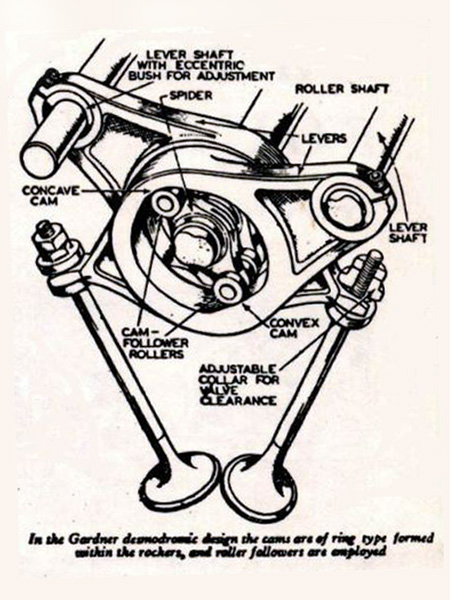
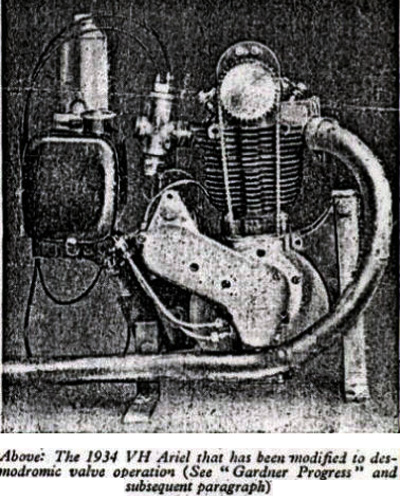
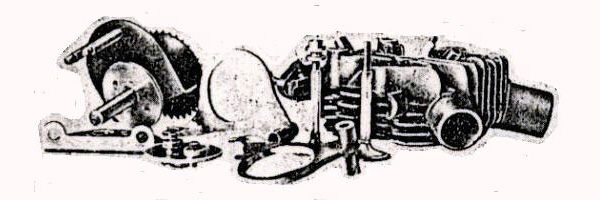
1959: MV Agusta 125 desmo double knocker
In 1959 MV Agusta started with the design of a 125 cc desmo double knocker with a very similar Mondial lay-out.Designed by Ruggero Mazza* who came from the race department of Ducati. The project was stopped in 1960, because MV Agusta, like Ducati, stopped racing in this discipline.
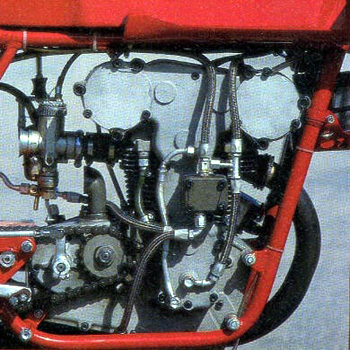
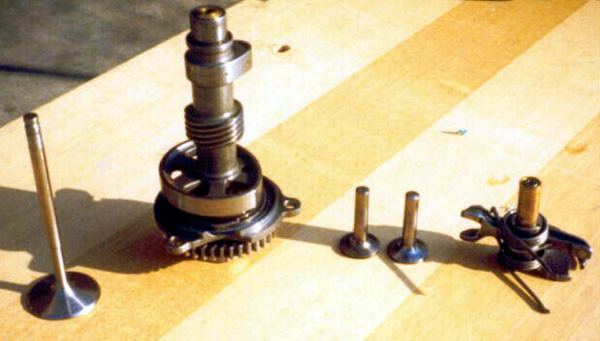
1960: OSCA F1 - 1500 cc V8 - Italy
Taglioni also worked on a Formula 1 project desmo. In 1960 at Osca Fratelli Maserati (not to be confused with Maserati, the brothers had sold the brand to the Orsi family) he participated in the design of a 1500 cc V8 engine with air-cooled cylinder heads separated.The prototype single-cylinder exploded on the test bench but, much to the relief of Taglioni, the Desmodromic was intact! Finally the 8 cylinders Osca 1500 reached 170 hp at 11,000 rpm, very correct figure for the time, but this project remained there for lack of means.
Note the original dual overhead cam V8 Osca bunk: another way of around the patent Mercedes simpler than the "trialbero". This is also the only desmo twin cam that has made Taglioni.
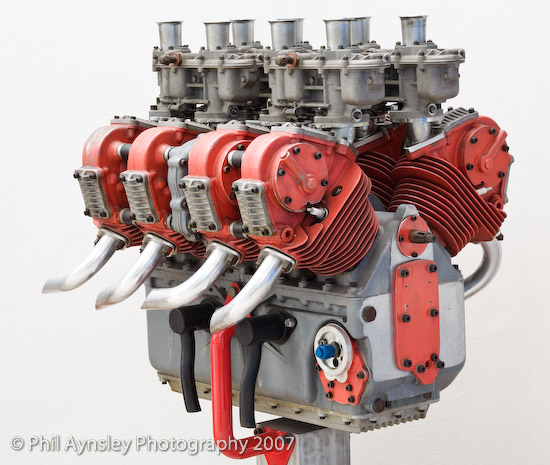
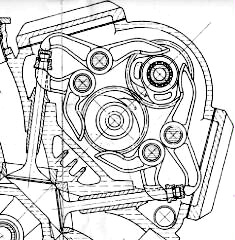
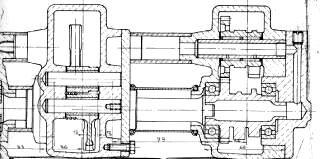
1962: PORSCHE TYPE 753 for Formula 1 - Germany
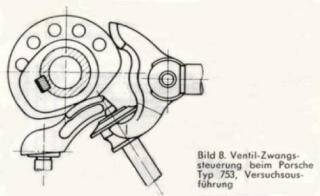
1962: Morini 250 GP single - Italy
Non-desmo 250 GP machine was also converted (1962) to desmodromic valve gear. According to Carlo Perelli in an article in "das Motorrad" the desmomotor was bench-tested at full throttle for 20 hours without any defect.
1962: ESO 250 single -
Miloslav Soucek used this desmo-machine in the 1962 Swiss GP.The sliding camfollower body very much resembles the Czech Karel Horal system. Not a radial valve type engine, but a "simple" two valve desmo system.
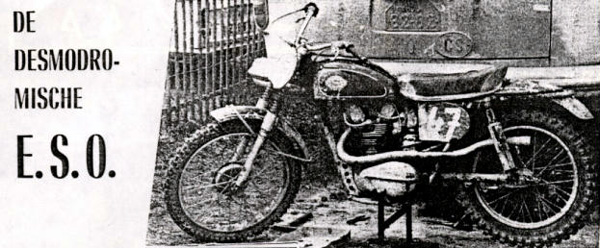
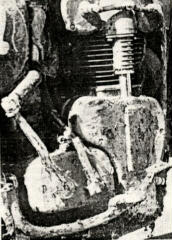
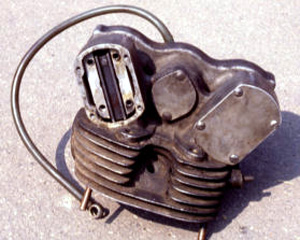
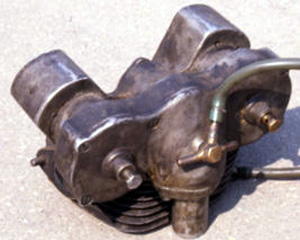
1963: Velocette Desmo conversion kit - USA
And also this kit desmodromic created by Alfred Woods in 1963 for BMG and engines intended for Velocette Venom Viper and rockers. Produced in small series, it worked very well:a 350 Viper Competition took 9000 rpm!
The English Sid Willis and Harry Hinton also built desmo Velocette.
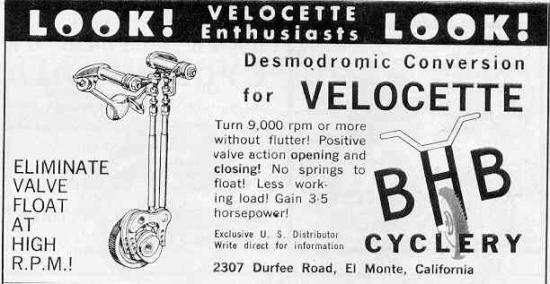
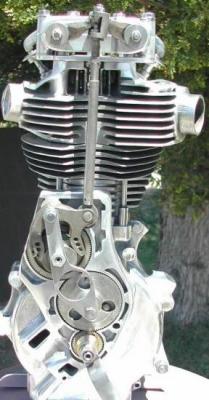
1968: the first mass-produced desmo by DUCATI - Italy
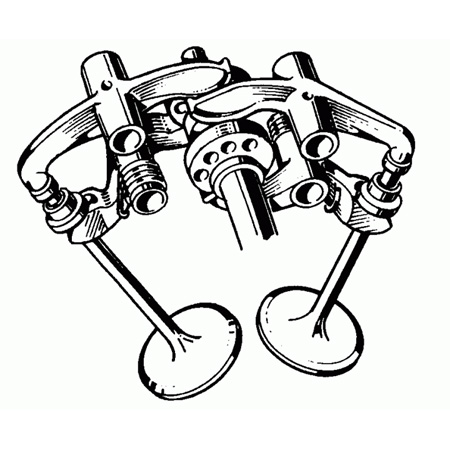
To see the first mass-produced desmo, we will have to wait until the Mark 3 Desmo 350 in 1968. This bike has practically the same timing system as today's twin-cylinder, two-valve bikes, which is evidence of its exceptional efficiency.
1986: BMW SOHC 2v & 4v desmo - Privet work by Franz Pohn - Germany
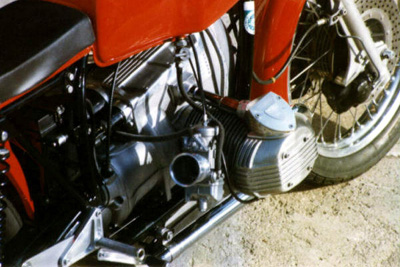
The magnificent flat-twin desmo single overhead cam 4-valve BMW "Desmo Quattro" built by craftsmen German Franz Pohn, it works perfectly. Previously he had directed a BMW two-valve desmo.
SOHC 2V
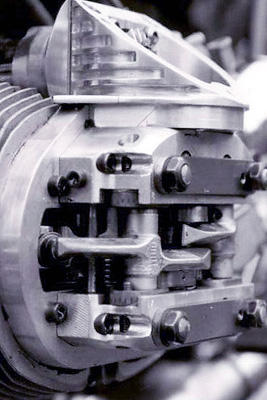
SOHC 4V
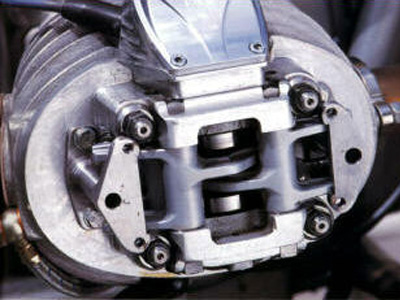
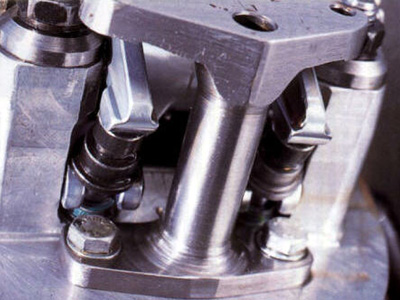
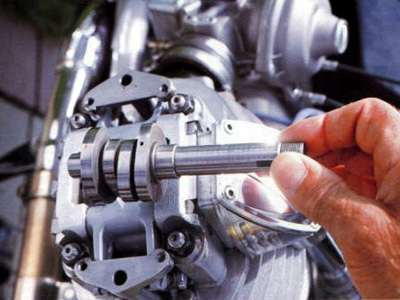
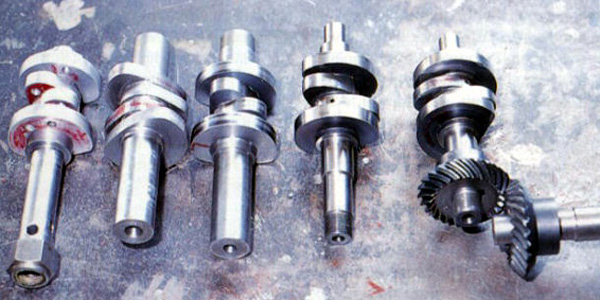
1989-92: BMW R1 Prototype - DOHC 4v desmo - Germany
R1 Project 1989-1992 The R1-reserchteam: Georg Emmersberger (Desmodromics), Heinz Hege and Ralf Lewien designed this BMW R1 Prototyp, that unfortunately never will come in production.
Tech specs:
Performance: 135 -140 Hp (100 - 103 KW). max rpm 11.000
Engine:
4-stroke two-cil. boxerengine, liquid cooled. Four valves per cil. ; DOHC DESMODROMIC VG
Bore-stroke: 98 x 66 mm. 996 ccm.
Bosch Fuelinjection; electronic ignition, 6 gear, cardan.
Dry weight 165 kg.
From the R1 till 1992 only 4 prototypes were made. One of them is ridable.
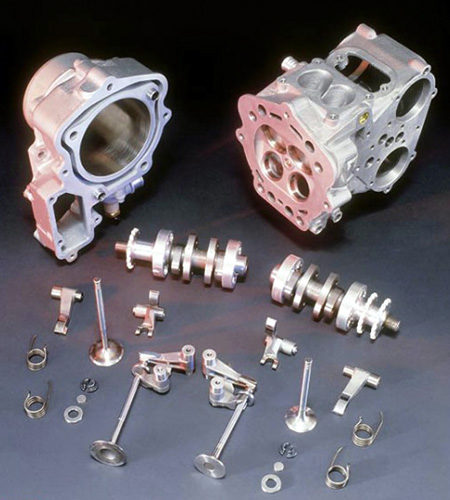
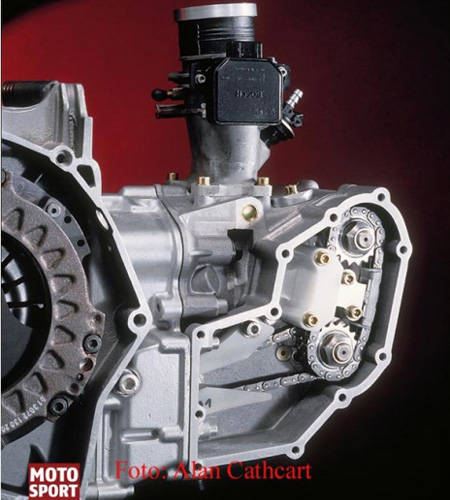
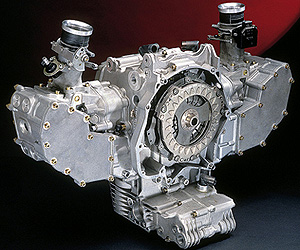
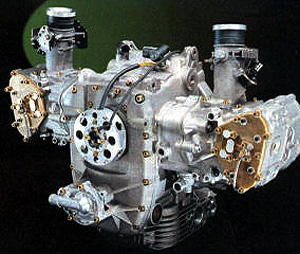
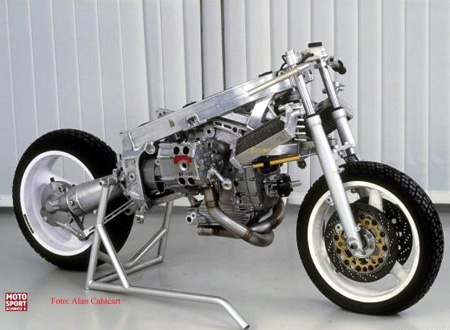
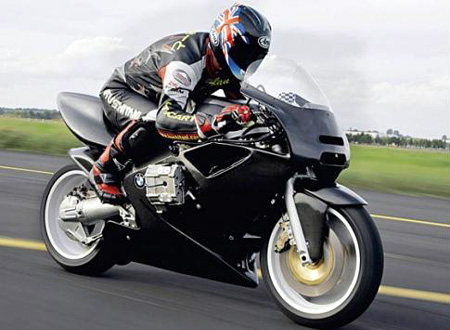
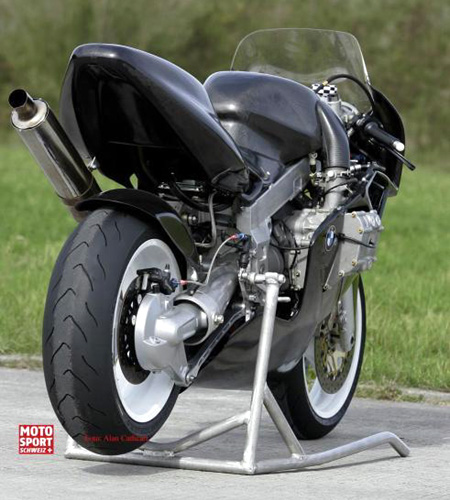
1989: Ferrari Type 035-5 for F1 - 3.5L 65deg. V12 60-valve desmo !! - Italy
Experimental cylinder head for 1989 3.5 liter V12 engine desmo Formula 1 , the system is a variant of Ducati "desmoquattro", it was designed by engineer Marchetti who also designed the breech Ducati "Testastretta". It is visible at the "Galleria Ferrari", the museum of the factory in Maranello.Count the number of cams per cylinder: 10 I see, so it's a 5-valve ... abandoned as a bit complicated ? Over 200 hp / liter still.
With 60 valves it could have been called the "Ferrari Desmosessanta"! A thought for the mechanics who had set the game by Valve 120 pellets desmo system ...
